Kabukichō
This article needs additional citations for verification. (December 2006) |
Kabuki-chō
歌舞伎町 | |
|---|---|
Entertainment and red-light district | |
 Kabukichō Ichiban-gai and colorful neon street signs | |
| Nickname(s): Sleepless Town (眠らない街) | |
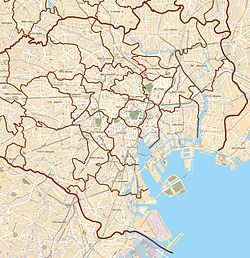 Kabuki-chō | |
| Coordinates: 35°41′38″N 139°42′12″E / 35.69388°N 139.703422°ECoordinates: 35°41′38″N 139°42′12″E / 35.69388°N 139.703422°E | |
| Country | Japan |
| Region | Kantō |
| Prefecture | Tokyo |
| Special ward | Shinjuku |
| Area | |
| • Total | 36 ha (89 acres) |
| Time zone | UTC+9 (Japan Standard Time) |
| Website | www |
Kabuki-chō (歌舞伎町) is an entertainment and red-light district in Shinjuku, Tokyo, Japan. Kabuki-chō is the location of many host and hostess clubs, love hotels, shops, restaurants, and nightclubs, and is often called the "Sleepless Town" (眠らない街). Shinjuku Golden Gai, famous for its plethora of small bars, is part of Kabuki-cho.
The district's name comes from late-1940s plans to build a kabuki theater; although the theater was never built, the name stuck.
The area has many movie theaters, and is located near Shinjuku Station, Seibu Shinjuku Station, and several other major railway and subway stations.
History[]

Originally, the area was known as Tsunohazu (角筈) and was a swamp. After the Meiji Period, the area became a duck sanctuary. As the Yodobashi Purification Plant was built in 1893, the ponds were filled in. In 1920, a girls' school was built there, and the surroundings were developed into a residential area. Prior to World War II, the district was one of the areas open to foreign-born property owners (primarily from Taiwan and Korea), who mainly operated tsurekomi yado, predecessors to today's love hotels.[1]
During the war, a bombing raid on April 13, 1945, razed the area to the ground.[1] After the war, Kihei Suzuki from the Association of Readjustment and Reconstruction of Shinjuku worked with the major landowner, Mohei Minejima to draw up plans for Kiku-za, a kabuki theatre, in the area; they believed that performers from the Kabuki-za theatre in Ginza would accept their invitation to perform at Kiku-za.[1] As a result, Hideaki Ishikawa, a regional planner, dubbed the town Kabuki-chō, which was adopted on April 1, 1948. Although the theatre was cancelled due to financial problems, the name remained. The (to the south, in Shibuya), movie theater, Tokyo Ice Skating Rink, and Shinjuku Koma Theater were all completed in 1956, cementing the area's reputation as an entertainment center.[2]
Kabuki-chō was quickly redeveloped after the war, mainly due to the efforts of the overseas Chinese in Japan who bought land left unused after the expos and greatly developed them. The "three most renowned overseas Chinese of Kabukicho" include the founder of Humax, , who started his business with a cabaret; Lin Tsai-wang, who built the Fūrin Kaikan; and Lee Ho-chu, owner of the Tokyo Hotel Chinese restaurant.[3] In 2002, it was estimated that 70% of the land in Kabukichō was owned by foreign-born Japanese residents and their descendants.[1] The rise of home video entertainment decreased the demand for live performances and film theaters, and Kabukichō became home to a number of video arcades, discos, and fuzoku (businesses offering sexual services).[4]
, a freelance portrait photographer who took pictures and sold prints back to his subjects for a modest ¥200, documented the citizens of Kabukichō during this transition period in the 1960s and 1970s.[5][6] Katsumi had apprenticed to a portrait studio in Tokyo shortly after moving there in 1962; he took his street photography portraits at night using a strobe as a side job.[7][8] In 1971, , a former mattress salesman, opened "Club Ai",[9] the first host club in Kabukichō; at its peak, Aida's company reported ¥2.7 billion in annual revenue.[4]


By 1999, the area had been named "Asia's largest adult entertainment district", and tabloids were regularly running candid photographs of drunken Kabukichō patrons fighting and being arrested.[4] However, starting in 2003, joint citizen and police patrols began enforcing business licensing,[10] and the 1948 Businesses Affecting Public Morals Regulation Act was more strictly enforced as well starting in April 2004, forcing adult-themed businesses to start removing customers at midnight in preparation to close by 1 AM. Kabukichō leaders attributed the change in enforcement to Tokyo Governor Shintaro Ishihara and the Tokyo bid for the 2016 Summer Olympics.[11][12]
At present, the 36 ha (89 acres; 0.14 sq mi) Kabukichō district[4] has transformed from a residential area to a world-famous red-light district housing over three thousand bars, nightclubs, love hotels, massage parlours, hostess clubs and the like. Although referred here as a "red light district", there are no red lights in the literal sense with sex workers in the windows as in Amsterdam.
Recently, tourism from China and Korea is on the rise, and so, many tourists can be seen in Kabukichō even during daytime. After several large hotels opened in the district, the Kabukicho Concierge Association was formed to recommend businesses that would be safe for foreign patrons, as the area is notorious for the practice known as bottakuri, where some businesses add exorbitant hidden fees to bring the final bill well beyond the initial advertised prices.[4]
Geography and statistics[]
- Points of interest
- Transportation
- Parks and open spaces
Kabukicho is generally bounded by:
- Railroad tracks (on the west)
- 靖国通り (Yasukuni-Dōri) (on the south)
- (Meiji-Dōri (明治通り), on the east)
- (Shokuan-Dōri (職安通り), on the north)
Notable locations[]

The red Kabukichō Ichiban-gai (歌舞伎町一番街) gate, near the southwest corner along Yasukuni-Dōri, is often photographed as the main entrance to Kabukichō. Other major entrances, east of Ichibangai-Dori along Yasukuni-Dori, include Central Road (セントラルロード, Sentoraru Rōdo), where the Kabukichō branch of Don Quijote is; and another neon-lit arch at Sakura-Dōri (さくら通り).
The Shinjuku Koma Theater was a landmark in Kabukichō. By 2008, it had moved to its third location; since it opened in 1956, it has hosted concerts and other performances by top stars, including enka singers Saburō Kitajima, Kiyoshi Hikawa, and actor Ken Matsudaira. The management announced that they would close after the December 31, 2008 show, and the building was demolished in 2009.[13] The site was redeveloped and the Toho Shinjuku Building was completed there in 2014, including the 12-screen Toho Cinemas Shinjuku theatre and the Hotel Gracery Shinjuku. A "life-size" replica of Godzilla (from the neck up) was added to an outdoor terrace in 2015; it has since become a local landmark.[14]

The Tokyu Milano-za movie theater, just west of Cinecity Square, was the largest in Japan when it opened in 1956.[2] Its last day of operation was December 31, 2014, closing after a screening of the film E.T. the Extra-Terrestrial.[15] A 225-metre (738 ft) high skyscraper is planned to be built on the site.[16]
Crime[]
In 2004, according to a spokesperson of Metropolitan Tokyo, there were more than 1,000 yakuza members in Kabukichō, and 120 different enterprises under their control.[17][full citation needed]
Entering the new millennium, laws were more strictly enforced and patrols became more frequent. In addition, fifty closed-circuit cameras were installed in May 2002 after the Myojo 56 building fire that killed 44;[1][11][18] the patrols and cameras reduced criminal activities in Kabukichō, amidst controversy.[12]
Private citizens and government agencies launched a joint effort in July 2003, called the Shinjuku Shopping Center Committee to Expel Organized-Crime Groups, with the aim to replace unlicensed and adult-oriented businesses (which were believed to pay protection fees to organized crime groups) with legitimate businesses.[10] In 2004, the police undertook an operation clamping down on illegal clubs and brothels, causing many to go out of business. An amendment to the 1948 Adult Entertainment law made aggressive catching of female patrons by male hosts illegal.[12] Also, the Kabukichō Renaissance organization started in April 2008 to rid Kabukichō of the yakuza; office manager Yoshihisa Shimoda stated "[a]t the end of the day, we want Kabukicho to be clean. We want security, safety and a pleasant environment."[11]
In 2011, Tokyo began to enforce the Organised Crime Exclusion Ordinance, which makes it a crime for businesses or individuals to deal with the Yakuza.[19] Although the punishment for violating the ordinance ranges up to one year in prison and a fine of ¥50,000, it is intended to provide an excuse for refusing to make protection payments.[20]

Bottakuri[]
Bottakuri is a form of bait-and-switch, where patrons are attracted by a low advertised price but then charged numerous hidden fees. In one instance, a group of nine was lured into a bar under the promise the all-inclusive cost was ¥4,000; the hostesses inside consumed 172 drinks and the final bill was ¥2,663,000. The staff at the bar allegedly threatened the patrons to ensure payment. In 2015, there were 1,052 reported cases of bottakuri in the first four months of the year alone, particularly targeting foreign tourists from China and Korea,[21] prompting a crackdown that began in May; in July, there were only 45 reported cases of bottakuri and 28 bars had been shut down.[22]
In 2007, local businessman Takeshi Aida founded the Shinjuku Kabukicho Host Club Anti-Organized Crime Gang Association to disassociate host and hostess clubs from organized crime, reduce the aggressive "catching" street solicitations, and eliminate the bottakuri practice.[12]
In media[]
Kabukichō has been featured in:
- Yakuza and Judgement (video game series), as Kamurocho[23]
- Gin Tama (manga)
- City Hunter (manga)
- Tokyo Vice (2009 memoir by Jake Adelstein)
- (manga)
- Persona 5 (video game) as "歓楽街" or "Entertainment District"
- Weathering with You (film)[24]
- Case File nº221: Kabukicho (anime television series)
- Tokyo Afterschool Summoners (Role-playing game)
- Cells at Work! Code Black as "kanzō (肝臟)" or "Liver"
- Ichi the Killer (both film and manga)
Gallery[]
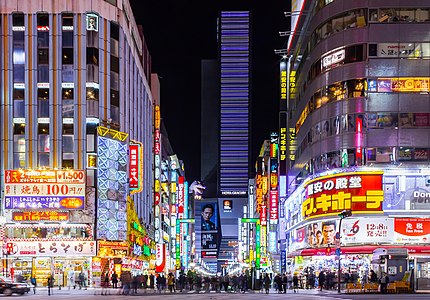
View north along Central road towards Toho Building
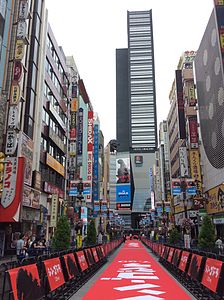
Shinjuku Toho Building
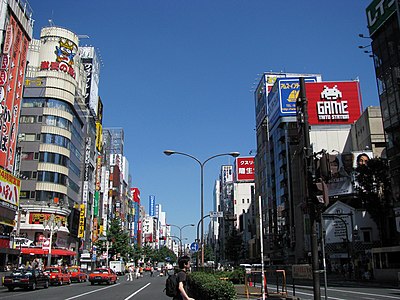
View east along Yasukuni-Dori, the southern border
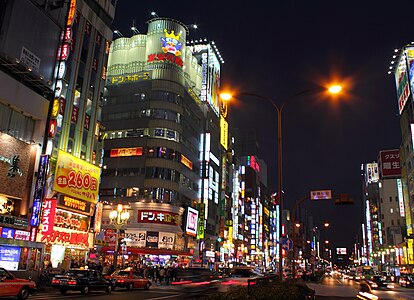
View east along Yasukuni-Dori at night
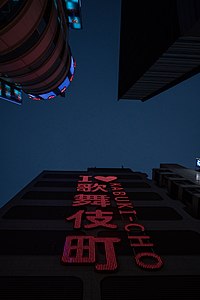
I ♥ Kabuki-chō sign

Gate at Sakura-Dori, looking north from Yasukuni-Dori

Sakura-Dori at dusk
Signs along Sakura-Dori, including entrance to the Robot Restaurant

Show at the Robot Restaurant
See also[]
- Jūsō, Osaka
- Kyabakura Union
- Tobita Shinchi, Osaka
References[]
- ^ Jump up to: a b c d e Schreiber, Mark (January 20, 2002). "Kabukicho: where worlds collide". Japan Times. Retrieved 20 November 2019.
- ^ Jump up to: a b "A City represent its people: A History of Kabukicho". kabukicho.or.jp. Retrieved 18 November 2019.
- ^ last, Nojima. "Tokyo's Kabukicho - City of the Taiwanese". CommonWealth. Retrieved 22 November 2019.
- ^ Jump up to: a b c d e Schreiber, Mark (May 23, 2015). "The changing face of Tokyo's 'red-light' district". Japan Times. Retrieved 19 November 2019.
- ^ Spaeth, Ryu (2015). "Tokyo demimonde". The Week. Retrieved 22 November 2019.
- ^ Knapp, Rancky (March 28, 2019). "An Insider Peep into Tokyo's Secretive Red Light District: Then & Now". Messy Nessy Chic. Retrieved 22 November 2019.
- ^ Katsumi, Watanabe (1967). "Untitled". The Metropolitan Museum of Art. Retrieved 22 November 2019.
- ^ "Katsumi Watanabe 'Shinjuku'" (Press release). Taka Ishii Gallery. September 2015. Retrieved 22 November 2019.
- ^ McCurry, Justin (17 September 2004). "Tokyo plays host to sexual shift". The Guardian. Retrieved 22 November 2019.
- ^ Jump up to: a b Prideaux, Eric (June 13, 2004). "Cops and citizens bid to blitz street sleaze". Japan Times. Retrieved 19 November 2019.
- ^ Jump up to: a b c Bull, Brett (December 22, 2008). "Last call for Kabukicho red-light district". Japan Today. Retrieved 19 November 2019.
- ^ Jump up to: a b c d "Kabukicho comes clean". Tokyo Reporter. May 2, 2008. Retrieved 19 November 2019.
- ^ 「演歌の殿堂」新宿コマ、今年限りで閉館 (1/2ページ) ["Enka's Hall of Fame" Shinjuku Koma, closed only for this year]. MSN産経ニュース (in Japanese). Archived from the original on 2008-05-31. Retrieved May 28, 2008.
- ^ "Godzilla to receive Shinjuku 'residency'". Tokyo Reporter. April 5, 2015. Retrieved 18 November 2019.
- ^ Warnick, BJ (31 December 2014). "Fans throng the Shinjuku Milano-za movie theater in Tokyo's Shinjuku Ward on Dec. 31, 2014, the last day of its operation, to see the American film "E.T.," chosen for the last screening. The movie theater, one of the largest in Japan with 1,064 seats, opened in December 1956". Alamy. Newscom. Retrieved 18 November 2019.
- ^ Okada, Mizuki (August 14, 2019). "Shinjuku Tokyu Milano Promises New Ways to Enjoy Kabuki-cho Nightlife Come 2022". Japan Forward. Retrieved 18 November 2019.
- ^ 2004年1月19日竹花東京都副知事発言・歌舞伎町住民との懇談会
- ^ "Gas pipes ruled out as cause of Kabukicho blaze". Japan Times. September 4, 2001. Retrieved 20 November 2019.
- ^ Chou, Chan Tau (23 August 2012). "Meeting Japan's yakuza". Al Jazeera. Retrieved 19 November 2019.
- ^ Adelstein, Jake (November 2, 2019). "It's illegal to pay gangs ... but that's not the point". Japan Times. Retrieved 20 November 2019.
- ^ Kodera, Atsushi (June 17, 2015). "How one Kabukicho bar allegedly ripped off its drinkers". Japan Times. Retrieved 19 November 2019.
- ^ "Police crackdown curbing extortionist Kabukicho 'bottakuri' bar rip-offs". Japan Times. Kyodo. August 12, 2015. Retrieved 19 November 2019.
- ^ https://www.youtube.com/watch?v=MilVxavlXMc
- ^ Salupen, Mark (1 October 2019). "The real Tokyo locations from Makoto Shinkai's anime movies". The Japan Times. Retrieved 4 February 2020.
External links[]
| Wikimedia Commons has media related to Kabuki-chō. |
- Kabukicho Renaissance official website (in English)
- KABUKI町 Kabukicho portal site (in Japanese)
- Kabukicho Commune (in Japanese)
- Neighborhoods of Tokyo
- Red-light districts in Japan
- Districts of Shinjuku
- Yakuza














